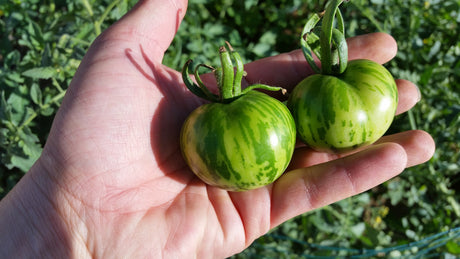
Heirloom Tomato Grow Kit Instructions
We recently added a new "kit" at Mary's Heirloom Seeds to grow your own Heirloom Tomatoes. Our goal is to help you grow a healthy garden so we have instructions...
Mary Smith |
Welcome to our store Learn more

We recently added a new "kit" at Mary's Heirloom Seeds to grow your own Heirloom Tomatoes. Our goal is to help you grow a healthy garden so we have instructions...
Mary Smith |

We're so excited to be Transplanting Seedlings today into our garden. Thank you for joining us for Day 8 of our series Grow Your Own Food in 100 Days or...
Mary Smith |

Welcome to Day 7 of our series Grow Your Own Food in 100 days or Less at Mary's Heirloom Seeds! These are the extra Heirloom Corn seedlings that didn't make...
Mary Smith |

Welcome to Day 5 of our series Grow Your Own Food in 100 Days or Less. WE HAVE GERMINATION! Actually, we had germination of the Early Scarlet Globe radish on...
Mary Smith |

Day 3 of our Series Grow Your Own Food in 100 Days or Less is underway! Water is an important aspect of any veggies garden. Whether you're using coconut coir...
Mary Smith |

Thank you for joining us for Day 2 of our series Grow Your Own Food in 100 Days or Less at Mary's Heirloom Seeds. Yesterday we jumped in and planted...
Mary Smith |

Mary's Heirloom Seeds Quick Links Echinacea GARDENS FUNDRAISER Seed Starting SUPPLIESOrganic Plant Food Organic Pest Control Heirloom BEANS Heirloom BEETS Heirloom CABBAGE Heirloom CARROTS Heirloom CORN Heirloom...
Mary Smith |

As promised, we are expanding our vegetable seed planting guide and including Oregon. This is one of many region-specific guides offered here at Mary's Heirloom Seeds. Find a complete list...
Mary Smith |

As promised, we are expanding our vegetable seed planting guide and including Oregon. This is one of many region-specific guides offered here at Mary's Heirloom Seeds. Find a complete list...
Mary Smith |

Are you ready for August and all of the amazing seeds to Plant? Alaska Pea (pictured) Don't miss out on our 99 CENT SEED PACKS! Mary's Heirloom Seeds Quick Links...
Mary Smith |

Mary's Heirloom Seeds Quick Links Echinacea Seed Starting SUPPLIESOrganic Plant Food Organic Pest Control 15 ORGANIC GIFTS IDEAS UNDER $20 Savoy Cabbage Heirloom BEANS Heirloom BEETS Heirloom CABBAGE...
Mary Smith |

Mary's Heirloom Seeds Newsletter JULY Seed Planting Guide for the US by Region NEW ARRIVALS ADDED TODAY! KABOCHA SQUASH Also know as Naguri Squash. A winter squash variety. Portuguese sailors...
Mary Smith |

As a homesteader, we are always looking for old varieties of heirloom seeds to feed our family and animals. I find that heirloom varieties have withstood the test of time...
Mary Smith |
Before we get started with our MAY Planting Guide, we have a few specials to announce. Genovese Basil and Sage will be on Sale thru May 10th Mary's Heirloom...
Mary Smith |